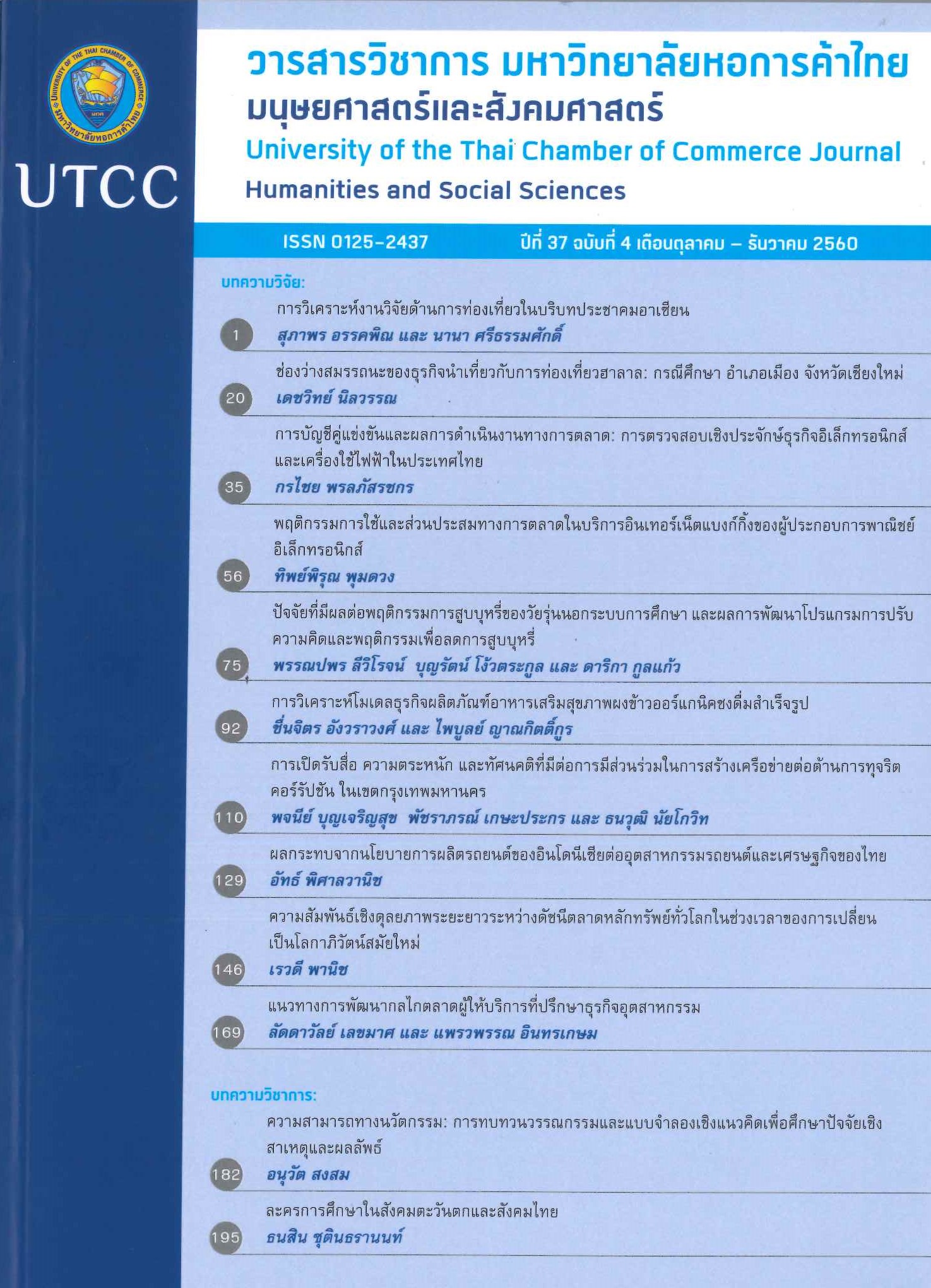Competitor Accounting and Marketing Performance: An Empirical Investigation of Electronics and Electrical Appliance Businesses in Thailand
Main Article Content
Abstract
This study’s objective is to investigate the effects of competitor accounting on marketing performance of electronics and electrical appliance businesses in Thailand through marketing capability, marketing effectiveness and competitive advantage as the mediators. Competitor accounting includes competitor cost assessment, competitive position monitoring and competitor performance appraisal. Research samples comprise 175 electronics and electrical appliance businesses in Thailand. A questionnaire is used to collect data. The quality of research tool is statistically tested using factor analysis, discriminant power and reliability, and the results are
considerably accepted. Correlation analysis and multiple regression analysis are applied for testing the research hypotheses. Findings reveal that both competitor cost assessment and competitor performance appraisal have significant effects on marketing capability and competitive advantage while competitive position monitoring has an important influence on marketing capability, marketing effectiveness and marketing performance. In addition, marketing capability, marketing effectiveness,
competitive advantage, and marketing performance definitely relate to each other. This study attempts to integrate the competitor cost assessment, competitive position monitoring and competitor performance appraisal components of competitor accounting in the same model. It contributes to the existing literature in terms of driving marketing capability and marketing effectiveness and explaining competitive advantage and marketing performance. Executives can effectively utilize the advantages of initiating competitor accounting systems in an organization by allocating their resources for operational activities and strategies relating to competitors in order to gain sustainable competitive advantage and achieve superior performance in both financial and non-financial aspects.
Article Details
ลิขสิทธิ์ของบทความ
ผลงานที่ได้รับการตีพิมพ์ถือเป็นลิขสิทธิ์ของมหาวิทยาลัยหอการค้าไทย ห้ามมิให้นำเนื้อหา ทัศนะ หรือข้อคิดเห็นใด ๆ ของผลงานไปทำซ้ำ ดัดแปลง หรือเผยแพร่ ไม่ว่าทั้งหมดหรือบางส่วนโดยไม่ได้รับอนุญาตเป็นลายลักษณ์อักษรจากมหาวิทยาลัยหอการค้าไทยก่อน
References
Anderson, S., & Guilding, C. (2006). Competitorfocused accounting applied to a hotel context. International Journal of Contemporary Hospitality Management, 18(3), 206-218.
Appiah-Adu, K. (1999). Marketing effectiveness and customer retention in the service sector. The Service Industries Journal, 19(3), 26-41
Armstrong, J. S., & Overton, T. S. (1977). Estimating non-response bias in mail surveys. Journal of Marketing Research, 14(3), 396-402.
Cadez, S., & Guilding, C. (2007). Benchmarking the incidence of strategic management accounting in Slovenia. Journal of Accounting and Organizational Change, 3(2), 126-146.
Cadez, S., & Guilding, C. (2008). An exploratory investigation of an integrated contingency model of strategic management accounting. Accounting, Organizations and Society, 33, 836-863.
Chan, S. C. H., & Mak, W. (2012). Benevolent leadership and follower performance: The mediating role of leader-member exchange (LMX). Asia-Pacific Journal of Management,
29, 285-301.
Chen, K. (2014). Improving importanceperformance analysis: the role of the zone of tolerance and competitor performance: The case of Taiwan’s hot spring hotels.Tourism Management, 40, 260-272.
Churchill, G. A., Jr. (1979). A paradigm for developing better measures of marketing Constructs. Journal of Marketing Research, 16, 64-73.
Cooper, R., & Slagmulder, R. (1998). Strategic cost management. Management Accounting, 80(1), 14-15.
Fong, C. C. F., & Wong, J. (2012). Competitor analysis and accounting of social networking site service companies in China. Journal of Technology Management in China, 7(3), 243-254.
Griffith, D. A., Yalcinkaya, G., & Calantone, R. J. (2010). Do marketing capabilities consistently media effects of firm intangible capital on performance across institutional environments? Journal of World Business, 45, 217-227.
Guilding, C. (1999). Competitor-focused accounting: an exploratory note. Accounting, Organizations and Society, 24, 583-595.
Lamberti, L., & Noci, G. (2010). Marketing strategy and marketing performance measurement system: Exploring the relationship. European Management Journal, 28, 139-152.
Li, J. J., Zhou, K. Z., & Shao, A. T. (2009). Competitive position, managerial ties and profitability of foreign firms in China:An interactive perspective. Journal of International Business Studies, 40, 339- 352.
Milichovsky, F., & Simberova, I. (2015). Marketing effectiveness: Metrics for effective strategic marketing. Engineering Economics, 26(2), 211-219.
Nath, P., Nachiappan, S., & Ramanathan, R. (2010). The impact of marketingcapability, operations capability and diversification strategy on performance: A resourcebased view. Industrial Marketing Management, 39, 317-329.
Neter, J., Wasserman, W., & Kutner, M. H. (1985). Applied linear statistical models: Regression, analysis of variance, and experimental designs. (2nd ed.).Homewood, IL: Irwin.
Nunnally, J. C., & Bernstein, I. H. (1994). Psychometric theory. New York, NY: McGraw-Hill
Nwokah, N. G., & Ahiauzu, A. I. (2008). Managerial competencies and marketing effectiveness in corporate organizations in Nigeria. Journal of Management Development, 27(8), 858-878.
Pino, C., Felzensztein, C., Zwerg-Villegas, A. M., & Arias-Bolzmann, L. (2016). Nontechnical innovations: Market performance of exporting firms in South Africa. Journal of Business Research, 69, 4385-4393.
Radas, S., & Matovac, V. A. (2006). Competitive position and its relationship to Innovation. In L. Galetic (Ed.), Proceedings of the 3rd international conference on an enterprise
odyssey: Integration and distintegration (pp. 378-1391). Zagreb, Croatia: n.p.
Ripolles, M., & Blesa, A. (2012). International new ventures as “small multinationals”: The importance of marketing capabilities. Journal of World Business, 47, 277-287.
Saeidi, S. P., Sofian, S., Saeidi, P., Saeidi, S. P., & Saaeidi, S. A. (2015). How does corporate social responsibility contribute to firm financial performance?: The mediating role of competitive advantage, reputation and customer satisfaction. Journal of Business Research, 68, 341- 350.
Tsao, W. (2014). Enhancing competitive advantages: the contribution of mediator and moderator on stickiness in the LINE. Journal of Retailing and Consumer Services, 21, 933-941.
Wang, C. (2014). How relational capital mediates the effect of corporate reputation on competitive advantage: Evidence from Taiwan high-tech industry. Technological Forecasting and Social Change, 82, 167- 176.


